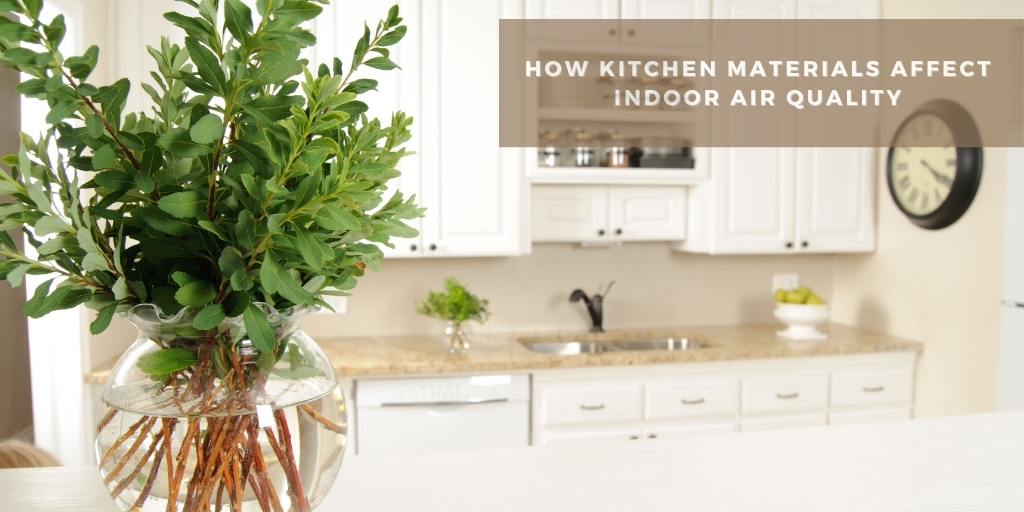
How Kitchen Material Selections Affect Indoor Air Quality
June 23, 2021
The things you put inside your home can greatly affect your health. Building materials, stains and paints, flooring, furniture, fabrics, and glues can all impact your home’s indoor air quality (IAQ). These pollutants are called volatile organic compounds (VOCs). They can cause respiratory irritation, headaches or other health problems. However, with the proper information and using the expert guidance of your remodeling professional, you can reduce indoor pollutants in your home.
The Kitchen
Items in the kitchen can have VOCs being emitted into the air, degrading the indoor air quality. These compounds can be emitted from the countertops, cabinets and flooring.
Not to worry, though. If this is a concern for you, there are ways to improve the indoor air quality in your kitchen simply by making smart material choices.
Countertop Materials
Countertops can contain additives that can break down and re-release themselves into the environment. For that reason, keep these points in mind during discussions with your professional remodeling firm on how countertops can be less intrusive to your home environment.
- Countertops that are made of natural stone (i.e., granite, slate, marble) or wood are the most sustainable and low-emitting options.
- Look for finishes that demonstrate the use of low chemical or particle emissions. Additionally, select a finish that is water-based and low-VOC rated as opposed to a petroleum distillate.
- Ask your contractor to use an adhesive that is low-VOC rated to install the countertops. Or, instead of adhesives, they may consider mechanical fasteners instead.
Kitchen Cabinets
There are many articles online about how kitchen cabinets contain formaldehyde, which is used in the adhesives to bind composite wood. This is true, but it’s not something to be scared of once you fully understand the context. According to the Kitchen Cabinets Manufacturers Association (KCMA):
“All wood species, and therefore all wood products, contain and emit small amounts of formaldehyde. An oak tree, for example, emits 9 parts per billion (ppb) of formaldehyde … Formaldehyde also is found in a wide range of fruits, vegetables, mushrooms, seafood, meats and coffee.”
All cabinetmakers use composite wood in the construction of cabinets, but they are not the only ones to use composite wood in construction. It is a vital material for the industry as a whole, but it is especially essential with cabinetmakers who build cabinets. Urea-formaldehyde adhesives are used to bind these materials together, which allow them to stand up to the durability and performance that homeowners expect while providing an appealing aesthetic.
Although you usually cannot avoid composite wood totally, this industry is regulated. Since 2013, all pressed wood sold in the United States must be California Air Resource Board (CARB) compliant, made with ultra-low emitting formaldehyde (ULEF) or no-added formaldehyde (NAF). These standards are the lowest in the world!
Keep in mind that although we are discussing kitchen cabinets, formaldehyde can be emitted from many other products you bring into the home. Here are some actions you can take to minimize exposure to formaldehyde:
- Ventilation is key when introducing any new products into the home. Open windows to bring in the fresh air and use fans to circulate the air. Keep in mind that the best-ventilated rooms in the home are already the kitchen and bath.
- Wood holds up best when heat and humidity are consistent. Monitor humidity levels in the winter and summer, which tend to be extremes of dry and humid, respectively.
Flooring Materials
Here are some things to consider when you are choosing flooring options for your home.
- Polished concrete or tile are great choices for zero-VOC, as they are inert and do not emit anything toxic.
- Most brands of engineered wood are eco-friendly with low-VOC. Look for a plywood or solid slat core, and a stain/varnish that is zero-VOC.
- Natural linoleum is made of all-natural products and is one of the greenest flooring options available today.
- For other parts of the home, natural wood floors are a great low-VOC choice, although it isn’t always the best option for the kitchen and bathrooms because of wet conditions.
- If you choose to lay down rugs on the hardwood or ceramic tile flooring, avoid synthetic or vinyl rugs. These emit higher amounts of VOCs.
Thoughtful selection choices during the renovation process can greatly improve your home’s indoor air quality. We can help you make selections based on wellness, durability and aesthetic appeal.
Contact us so we can learn more about your specific needs and make a plan together.